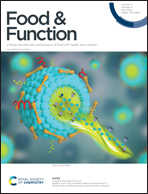Usage of supercritical fluid techniques to obtain bioactive alkaloid-rich extracts from cherimoya peel and leaves: extract profiles and their correlation with antioxidant properties and acetylcholinesterase and α-glucosidase inhibitory activities
Abstract
The agroindustrial sector is highly concerned with regards to reducing the environmental impact of waste from pruning activities (leaves, branches and bark) and from food industry processes (peels and seeds). In this sense, the wastes generated by cherimoya cultivation and processing industries should be contemplated as a valuable source of biologically active compounds. In this work, we have studied the bioactivity of alkaloid-rich Annona cherimola Mill. extracts obtain by means of supercritical fluid extraction techniques. The extracts were obtained from the peel and leaves using the following optimal conditions: 100 bar of pressure, 75 °C and 15% methanol as co-solvent. High antioxidant capacity (5304.23 ± 73.60 to 21 705.20 ± 1069.31 μmol Trolox equivalent per 100 g), and acetylcholinesterase (IC50 = 87.69 ± 3.42 to 515.02 ± 29.25 μg mL−1) and α-glucosidase (IC50 = 1097.76 ± 121.12 to 3206.88 ± 97.06 μg mL−1) inhibitory activities were exhibited by both peel and leaf extracts. Larger alkaloid contents were determined by UHPLC-ESI-MS analysis, with peel extracts presenting a high concentration of N-trans-feruloyl phenethylamine, while leaf extracts were rich in anonine. This work reports novel data on bioactivity of cherimoya peel and leaves and their potential as a source of bioactive compounds.



 Please wait while we load your content...
Please wait while we load your content...